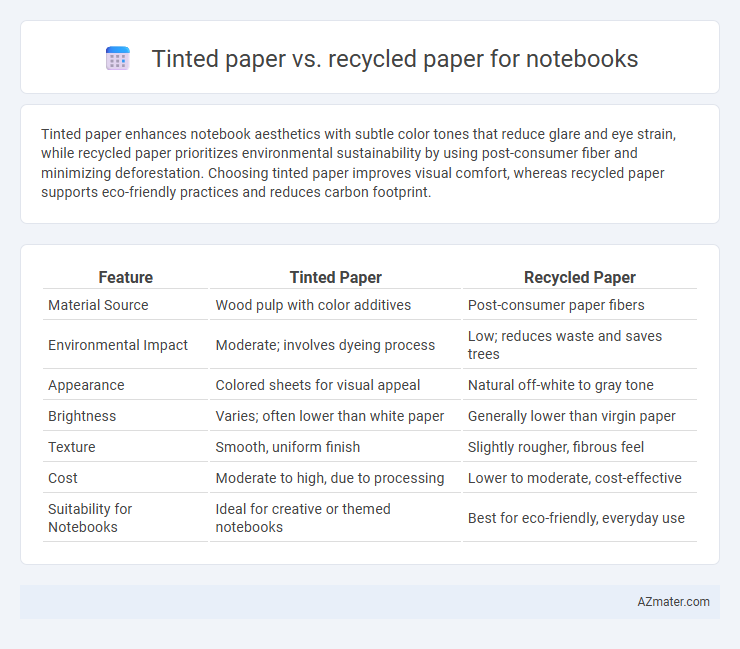Tinted paper enhances notebook aesthetics with subtle color tones that reduce glare and eye strain, while recycled paper prioritizes environmental sustainability by using post-consumer fiber and minimizing deforestation. Choosing tinted paper improves visual comfort, whereas recycled paper supports eco-friendly practices and reduces carbon footprint.
Table of Comparison
| Feature | Tinted Paper | Recycled Paper |
|---|---|---|
| Material Source | Wood pulp with color additives | Post-consumer paper fibers |
| Environmental Impact | Moderate; involves dyeing process | Low; reduces waste and saves trees |
| Appearance | Colored sheets for visual appeal | Natural off-white to gray tone |
| Brightness | Varies; often lower than white paper | Generally lower than virgin paper |
| Texture | Smooth, uniform finish | Slightly rougher, fibrous feel |
| Cost | Moderate to high, due to processing | Lower to moderate, cost-effective |
| Suitability for Notebooks | Ideal for creative or themed notebooks | Best for eco-friendly, everyday use |
Introduction to Tinted Paper and Recycled Paper
Tinted paper features a subtle color infusion that enhances visual appeal and reduces glare, making it ideal for creative notebooks and design-focused projects. Recycled paper, made from reclaimed fibers, offers an eco-friendly alternative that supports sustainability efforts while maintaining durability and print quality. Both options cater to different needs, with tinted paper emphasizing aesthetics and recycled paper prioritizing environmental responsibility.
What is Tinted Paper?
Tinted paper is paper that has been dyed or colored during the manufacturing process to produce a consistent hue throughout the sheet, enhancing visual appeal and reducing glare for easier reading. In notebooks, tinted paper offers a subtle background color that can improve writing contrast and eye comfort compared to standard white paper. Unlike recycled paper, which is made from reclaimed fibers to reduce environmental impact, tinted paper focuses on aesthetic and functional qualities without necessarily involving sustainable materials.
What is Recycled Paper?
Recycled paper is made from recovered fibers, including post-consumer and industrial waste, reducing the demand for virgin wood pulp and minimizing environmental impact. It undergoes processes like deinking and cleaning to remove contaminants, resulting in usable paper stock while conserving natural resources. This sustainable choice for notebooks supports waste reduction, energy savings, and lower greenhouse gas emissions compared to traditional paper production.
Environmental Impact of Tinted vs Recycled Paper
Recycled paper for notebooks significantly reduces deforestation and lowers greenhouse gas emissions by utilizing post-consumer waste, whereas tinted paper often requires additional chemical treatments and dyes that can increase its environmental footprint. The production of recycled paper conserves water and energy compared to virgin fiber tinted paper, making it a more sustainable choice for eco-conscious consumers. Selecting recycled paper over tinted options minimizes landfill waste and supports circular economy practices in the paper industry.
Visual and Aesthetic Differences
Tinted paper in notebooks offers a unique visual appeal with subtle color variations such as soft pastels or earth tones that reduce glare and enhance writing contrast. Recycled paper often features a natural, off-white or slightly greyish hue with visible fiber textures, conveying an eco-friendly and rustic aesthetic. While tinted paper emphasizes sophisticated color and mood, recycled paper highlights sustainability through its organic and textured appearance.
Writing Experience: Ink Absorption and Smoothness
Tinted paper in notebooks offers moderate ink absorption, enhancing visual contrast and reducing glare, which benefits writing clarity but may cause slight smudging with fast-drying inks. Recycled paper often features a rougher texture with variable absorbency, leading to increased ink bleed and feathering, potentially hindering smooth pen movement and precise writing. For optimal writing experience, tinted paper generally provides smoother ink flow and better control, whereas recycled paper may require specific pens to minimize ink spreading.
Health and Eye Strain Considerations
Tinted paper in notebooks reduces glare and blue light exposure, which can significantly decrease eye strain and improve reading comfort during extended use. Recycled paper, while environmentally friendly, sometimes has a rougher texture and higher opacity that may cause more eye fatigue under certain lighting conditions. Choosing tinted paper with smooth, high-quality finishes offers a health advantage by minimizing visual discomfort associated with prolonged writing or reading tasks.
Cost Comparison: Tinted vs Recycled Paper
Tinted paper typically costs 15-25% more than recycled paper due to the added expense of pigmentation and dye processes in manufacturing. Recycled paper benefits from lower material costs and sustainable sourcing, making it a more budget-friendly option for notebook production. Price differences can impact bulk purchasing decisions, with recycled paper offering better value for cost-conscious consumers and eco-friendly brands.
Durability and Longevity of Notebooks
Tinted paper in notebooks offers moderate durability with resistance to glare and eye strain, but it may fade over time due to exposure to light. Recycled paper, often treated for enhanced strength, typically provides greater longevity and durability, making it more resistant to wear and tear from frequent use. Choosing recycled paper notebooks supports sustainability while maintaining robust performance for long-term writing and archival purposes.
Choosing the Right Paper for Your Notebook
Choosing the right paper for your notebook depends on your priorities such as visibility, texture, and environmental impact. Tinted paper reduces glare and eye strain, making it ideal for extensive writing or sketching, while recycled paper emphasizes eco-friendliness by minimizing waste and conserving resources. Selecting between tinted and recycled paper balances personal comfort with sustainable practices for a customized notebook experience.

Infographic: Tinted paper vs Recycled paper for Notebook
 azmater.com
azmater.com